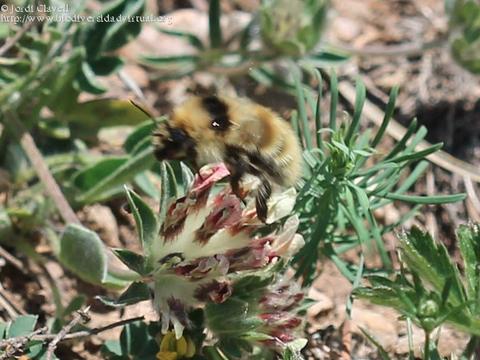Bombus mucidus
Bombus mucidus is a medium - small size species.
Females: 16-19 mm
Males: 13-15 mm
General body color is grayish yellow or olive. Black head and vertex, with yellow hairs intermixed. Pale yellow thorax, with an circular and dark interalar band. The rest of the body is yellow and can be orange in the last sections. T6 with black hairs.

It has not been evaluated.
No threats described.
Females: slightly elongated head. Length of malar space slightly larger than the distal height. The malar space has very small pits unevenly distributed. Labral prominent tubercles, slightly sharp and very dotted. The labral groove is narrow and very dotted. Elongated clypeus with sparse dotted. Indistinct apical impressions. A3 equal to or less than A4+5. Highly sculpted front. The bright areas are separated from the eyes by a broad band with pits. Slightly crosslinked tibia in hind legs. The basitarsus has a acute angle posterodistal T6 apical margin slightly up. The genitalia has narrow stings case external projections. Inner membranous projections, widened along its entire length.
Males: narrow and elongated head. Malar space is larger than its distal width. The jaws are thick and long beard. Long antennae. Narrow basitarsus with parallel sides that meet at the distal region. Convex tibia with a narrow slit in the post area to the half where there is a hairless area. Wide and short basitarsus.Rounded E6 . Slightly sharpened E7. Genitalia with narrow, curved sagittae, and a membranous dilatation in the end. Sawing apex. Short and narrow spathe. Very short, transverse, rounded escuamas with a rolled inwards having serrated edge.Very large and wide volselas, especially in the center with the sharp apex.
High mountains of southern Europe (Alps, Carpathians, Apennines and the Balkans). In the Iberian Peninsula is located in the Cordillera Cantabrica and the Pyrenees.
1400-2500 m.
Potential distribution map at the present time
Potential distribution map in 2050 with the same level of pollution emission and the climate changes consequence of these contamination levels
Map legend
Maps are made with GBIF data of this specie in Iberian Peninsula
Flight period: June-last August
Bombus mucidus has been collected in Fabaceae, Boraginacea, Asteraceae and Escrophulareacea.
Biotopes : high zones, mountain forests.